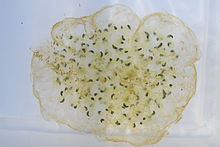Chlorococcum amblystomatis
| Chlamydomonad alga | |
|---|---|
| Scientific classification | |
| Domain: | |
| Kingdom: | |
| Division: | |
| Class: | |
| Order: | |
| Family: | |
| Genus: | Oophila
|
| Species: | O. amblystomatis
|
| Binomial name | |
| Oophila amblystomatis Printz, 1927[1]
| |

Oophila amblystomatis, commonly known as chlamydomonad algae or salamander algae, is a species of single-celled green algae. The Latin specific name means "loves salamander eggs". It does not occur anywhere in nature other than in the eggs of the spotted salamander, Ambystoma maculatum. The alga can invade and grow in the amphibian's egg capsule. Once inside, it metabolizes the carbon dioxide produced by the embryo and provides it with oxygen as a result of photosynthesis. This is an example of symbiosis,[2] and the only known example an intracellular endosymbiont microbe in vertebrates.[3][4]
This symbiosis between Oophila and the salamander may exist beyond the oocyte and early embryonic stage. Chlorophyll autofluorescence observation and ribosomal DNA analysis suggest that this algal species has invaded embryonic salamander tissues and cells during development and may even be transmitted to the next generation.[5]
See also
References
- ^ "Oophila amblystomatis". Integrated Taxonomic Information System. Retrieved 4 August 2008.
- ^ Nature Trivia, Spotted Salamander at Henderson State University. Accessed 4 August 2008.
- ^ Frazer, J. (2018-05-18). "Algae Living inside Salamanders Aren't Happy about the Situation". Scientific American. Retrieved 2018-05-21.
- ^ Burns, J. A.; Zhang, H.; Hill, E.; Kim, E.; Kerney, R. (2017). "Transcriptome analysis illuminates the nature of the intracellular interaction in a vertebrate-algal symbiosis". eLife. 6. doi:10.7554/eLife.22054.
{{cite journal}}: CS1 maint: unflagged free DOI (link) - ^ Kerney, Ryan; et al. (2011). "Intracellular invasion of green algae in a salamander host". PNAS. 108: 6497–6502. doi:10.1073/pnas.1018259108. PMC 3080989. PMID 21464324.
Further reading
- Gilbert, P. W. (1942). "Observations on the eggs of Ambystoma maculatum with especial reference to the green algae found within the egg envelopes". Ecology. 23 (2): 215–227. doi:10.2307/1931088.
- Kim, E.; Lin, Y.; Kerney, R.; Blumenberg, L.; Bishop, C. (2014). "Phylogenetic analysis of algal symbionts associated with four North American amphibian egg masses". PLoS ONE. 9 (11): e108915. doi:10.1371/journal.pone.0108915.
{{cite journal}}: CS1 maint: unflagged free DOI (link) - Valls, J. H.; Mills, N. E. (2007). "Intermittent hypoxia in eggs of Ambystoma maculatum: embryonic development and egg capsule conductance". J. Exp. Biol. 210 (14): 2430–2435. doi:10.1242/jeb.003541.
External links
- "Chlorococcum amblystomatis" at the Encyclopedia of Life
- Green Eggs and Jam: Adaptations That Help Spotted Salamanders Reproduce at Henderson State University.
- Ambystoma maculatum at AmphibiaWeb.
- Image of salamander egg with algae at North Carolina Museum of Natural Sciences.
